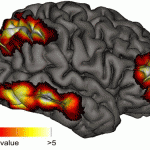
Computer simulated pyramidal cells in the hippocampus. These cells are thought to be involved in spatial memory and other cognitive functions. Image: M. Hausser/ UCL/ Wellcome Images.
Silent pyramidal cells in the hippocampus can be converted into active place cells.
Place cells in the hippocampus increase their firing rate whenever an animal is in a particular location that corresponds to their place field. It has been found that these cells are responsible for forming cognitive and spatial memory maps, which animals use to navigate through their environment.
Think, for example, how much easier it is to find your way around your own house in the dark than in some unfamiliar building. This is because your place cells have already formed memory representational fields of the different routes and objects around your home, whereas everything in the unfamiliar building is still completely novel.
Until recently, the origin of the spatial receptive fields of place cells was unknown. Scientists had established that each pyramidal place cell in the CA1 region of the hippocampus receives thousands of synaptic inputs, mostly from other spatially tuned neurons. But how these cells integrate and respond to the inputs they receive, and where place fields actually come from, has been virtually unexplored.
In a current study conducted by researcher Doyan Lee and colleagues at the Howard Hughes Medical Institute, Janelia Farm Research Campus, US, some unexpected information on place fields was collected. Existing models have generally assumed that the critical factor in place cell firing is the environmental location of the animal. For example, if an animal moves to the left, a different group of place cells will fire than if it were to move to the right or straight ahead. However, the researchers found that the most important factor might actually be the membrane properties of hippocampal cells.
“[A] critical aspect of neuronal integration is the interaction of synaptic inputs with the membrane properties of the post-synaptic cell,” the researchers explain in their paper, published in Science. “Inputs can be strongly filtered or amplified before determining output spiking, yet such features have not been included in place cell models.”
By experimentally stimulating pyramidal cells in rat hippocampi, as the animal moved around different mazes, the researchers observed the emergence of place fields. Interestingly, when the team experimentally induced excitation in a usually spatially untuned set of cells, called “silent cells”, they were converted into active place cells and receptive fields also emerged. “We discovered that, contrary to expectations from basic models”¦ [depolarisation] of a silent cell leads to the sudden and reversible emergence of a spatially tuned subthreshold response and place field spiking,” the scientists reveal.
These findings are quite remarkable, as they show how a seemingly inactive group of cells can be transformed into a highly excitable and spatially tuned type, simply by altering the membrane properties. “Such gating of inputs by postsynaptic neuronal excitability reveals a cellular mechanism for receptive field origin and may be critical for the formation of hippocampal memory representations,” they conclude.
Source: Science






